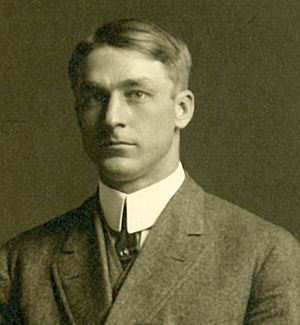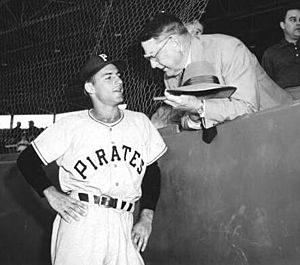Branch Rickey facts for kids
Quick facts for kids Branch Rickey |
|||||||||||||||||||||||||||||||||||||||||||
|---|---|---|---|---|---|---|---|---|---|---|---|---|---|---|---|---|---|---|---|---|---|---|---|---|---|---|---|---|---|---|---|---|---|---|---|---|---|---|---|---|---|---|---|

Rickey in the 1930s with the Cardinals
|
|||||||||||||||||||||||||||||||||||||||||||
| Catcher / Manager / Executive | |||||||||||||||||||||||||||||||||||||||||||
| Born: December 20, 1881 Portsmouth, Ohio |
|||||||||||||||||||||||||||||||||||||||||||
| Died: December 9, 1965 (aged 83) Columbia, Missouri |
|||||||||||||||||||||||||||||||||||||||||||
|
|||||||||||||||||||||||||||||||||||||||||||
| debut | |||||||||||||||||||||||||||||||||||||||||||
| June 16, 1905, for the St. Louis Browns | |||||||||||||||||||||||||||||||||||||||||||
| Last appearance | |||||||||||||||||||||||||||||||||||||||||||
| August 25, 1914, for the St. Louis Browns | |||||||||||||||||||||||||||||||||||||||||||
| MLB statistics | |||||||||||||||||||||||||||||||||||||||||||
| Batting average | .239 | ||||||||||||||||||||||||||||||||||||||||||
| Hits | 82 | ||||||||||||||||||||||||||||||||||||||||||
| Home runs | 3 | ||||||||||||||||||||||||||||||||||||||||||
| Runs batted in | 39 | ||||||||||||||||||||||||||||||||||||||||||
| Games managed | 1,277 | ||||||||||||||||||||||||||||||||||||||||||
| Managerial record | 597–664 | ||||||||||||||||||||||||||||||||||||||||||
| Winning % | .473 | ||||||||||||||||||||||||||||||||||||||||||
| Teams | |||||||||||||||||||||||||||||||||||||||||||
As player
As manager
As general manager
|
|||||||||||||||||||||||||||||||||||||||||||
| Career highlights and awards | |||||||||||||||||||||||||||||||||||||||||||
|
|||||||||||||||||||||||||||||||||||||||||||
| Induction | 1967 | ||||||||||||||||||||||||||||||||||||||||||
| Election Method | Veterans Committee | ||||||||||||||||||||||||||||||||||||||||||
|
|||||||||||||||||||||||||||||||||||||||||||
Wesley Branch Rickey (born December 20, 1881 – died December 9, 1965) was an important American baseball player and leader. Rickey is famous for helping to end the color barrier in Major League Baseball. He did this by signing black player Jackie Robinson.
Rickey also created the idea of the modern minor league farm system. This system helps young players develop their skills before playing in the major leagues. He also helped bring new teams into Major League Baseball and introduced the batting helmet for player safety. He was honored by being chosen for the Baseball Hall of Fame in 1967.
Rickey played in Major League Baseball (MLB) for the St. Louis Browns and New York Highlanders from 1905 to 1907. After his playing career, he became a successful manager and executive. He worked with the St. Louis Browns, St. Louis Cardinals, Brooklyn Dodgers, and Pittsburgh Pirates. The Cardinals added him to their team Hall of Fame in 2014.
Rickey also played football professionally for the Shelby Blues. He coached football at Ohio Wesleyan University and Allegheny College. Because of his many achievements and strong Christian faith, people sometimes called him "the Mahātmā" (a wise teacher).
Contents
Early Life and College Years
Branch Rickey was born in Portsmouth, Ohio. He graduated from Valley High School in Lucasville, Ohio, in 1899. He played as a catcher on the baseball team at Ohio Wesleyan University, where he earned his degree.
Rickey later went to the University of Michigan to study law. While there, he also coached the university's baseball team. He was very passionate about baseball and believed sports were important for college students. He coached Michigan's baseball team from 1910 to 1913, with a good record of 68 wins and 32 losses.
Playing Baseball and Football
Before becoming a famous baseball executive, Rickey played both football and baseball.
Playing Football
In 1902, Rickey played professional football for the Shelby Blues. This team was part of the "Ohio League", which was a very early version of the modern National Football League (NFL). While playing for Shelby, Rickey became friends with Charles Follis, who was the first black professional football player.
Rickey saw how Follis handled pressure and racism with grace. This experience, along with an incident involving a black baseball player named Charles Thomas on his college team, helped inspire Rickey to sign Jackie Robinson many years later.
Playing Baseball
Rickey started his professional baseball career in 1903. He made his major league debut with the St. Louis Browns in 1905. In 1907, he was traded to the New York Highlanders. However, he struggled as a player, both hitting and fielding. He even injured his throwing arm. After the 1907 season, he stopped playing professionally.
Baseball Executive Career
After his playing days, Rickey became a very important figure in baseball management.
St. Louis Browns (1913–1915)
Rickey returned to the major leagues in 1913, working in the front office for the Browns. He helped sign talented young players like George Sisler. He also managed the team for a short time in 1913 and for two full seasons after that.
Serving in World War I (1917–1919)
Rickey took a break from baseball to serve in the U.S. Army during World War I. He was an officer in France and commanded a special chemical training unit. Famous baseball players like Ty Cobb and Christy Mathewson were part of his unit.
St. Louis Cardinals (1919–1942)
After the war, Rickey joined the St. Louis Cardinals in 1919. He became the team's president and manager. In 1920, he focused on his role as an executive.
Rickey helped create the famous Cardinals uniform design with the two cardinal birds on a baseball bat. He saw a similar design at a church and worked with a graphic designer to create the team's iconic logo.
Even though he was fired as manager in 1925, the team's owner recognized Rickey's talent for finding and developing players. He was asked to stay and run the team's front office. This was a turning point for Rickey, as he became known as a master of baseball operations. He was like the first true "general manager" in baseball.
Building the Farm System
Rickey's biggest idea with the Cardinals was creating the "farm system". This meant the team owned several minor league clubs. These minor league teams would develop young players. This way, the Cardinals could grow their own talent instead of buying expensive players from other teams.
By the 1930s, Rickey's farm system was producing amazing players. The Cardinals, known as the "Gashouse Gang", won the World Series in 1931 and 1934. Stars like Pepper Martin, Dizzy Dean, and Joe Medwick all came from Rickey's minor league system.
The Commissioner of Baseball, Kenesaw Mountain Landis, was worried about Rickey's system. He thought it might harm other minor league teams. But Rickey's system proved to be very successful. Soon, every major league team adopted a similar farm system. It actually helped save the minor leagues by making them essential for player development.
In Rickey's last year with St. Louis, 1942, the Cardinals had their best season ever. They won 106 games and another World Series title. Many of their best players, like Enos Slaughter and Stan Musial, were developed through Rickey's system.
Brooklyn Dodgers (1942–1950)
In 1942, Rickey became the president and general manager of the Brooklyn Dodgers. He continued to bring new ideas to baseball.
New Ideas and Statistics
Rickey created the first full-time spring training facility in Florida. He also encouraged the use of new tools like batting cages, pitching machines, and batting helmets. He was also one of the first to use statistical analysis in baseball. He hired a statistician to study player data. This led him to believe that on-base percentage was more important than batting average.
Breaking the Color Barrier
Rickey's most famous act was signing Jackie Robinson. This broke baseball's color barrier, which had kept black players out of Major League Baseball since the 1880s. This was an unwritten rule, but it was very strong.
Rickey knew that Robinson would face a lot of racism and challenges. In their first meeting, Rickey told Robinson that he would have to be incredibly strong and patient. Robinson agreed not to fight back against the unfair treatment. He knew that his actions would affect all future black players in baseball.
On August 28, 1945, Rickey signed Robinson to a minor league contract. Robinson had been playing in the Negro leagues. In 1946, Robinson played for the Montreal Royals, the Dodgers' top minor league team. He was a star, winning the batting title.
In 1947, Jackie Robinson made his debut with the Brooklyn Dodgers. He became the first black player in modern Major League Baseball. He won the first Rookie of the Year award. Despite facing insults and discrimination, he became very popular. His success opened the door for other black players, like Larry Doby, who joined the American League in 1947.
Rickey's decision was both about fairness and good business. He knew there were many talented black players in the Negro leagues. The first team to sign them would get the best players at a good price.
The Dodgers made it to the World Series in 1947, showing how Rickey's vision had made them a top team.
Pittsburgh Pirates (1951–1955)
After leaving the Dodgers, Rickey became the general manager of the Pittsburgh Pirates in 1950. The Pirates were not a good team at the time. Rickey started to rebuild the team from scratch, focusing on young players.
One of his notable changes in Pittsburgh was making the Pirates the first team to regularly use batting helmets in 1953. These early helmets looked like a "miner's cap". Rickey believed in player safety.
Rickey retired in 1955 due to health problems. The Pirates were still struggling, but Rickey had laid the groundwork for future success. Many of the young players he brought in, like Roberto Clemente and Bill Mazeroski, helped the Pirates win the World Series in 1960.
Continental League President
In 1959, Rickey took on a new challenge. He became the president of a proposed third major baseball league called the Continental League. This league was planned because many cities wanted major league teams, and the existing two leagues were not expanding fast enough.
Rickey believed a new league would be good for baseball. However, the existing Major League Baseball teams decided to expand their own leagues instead. This led to the Continental League being canceled. But it did result in new teams being added to MLB, like the New York Mets and Houston Colt .45s.
Return to Cardinals
In 1962, Rickey returned to the Cardinals as a special advisor. He wanted to be closer to home after a heart attack and the death of his son. He continued to advise the team on player development. Rickey retired from baseball in 1964.
Death
On November 13, 1965, Branch Rickey collapsed while giving a speech in Columbia, Missouri. He was being inducted into the Missouri Sports Hall of Fame. He never woke up and died on December 9, 1965, just before his 84th birthday. He was buried in Rushtown, Ohio.
Honors and Legacy
Branch Rickey is remembered as one of baseball's greatest innovators. He changed the game in many ways.
- He was elected to the Baseball Hall of Fame in 1967.
- In 1997, he was inducted into the St. Louis Walk of Fame.
- In 2009, he was elected to the College Baseball Hall of Fame.
- In 2014, he was part of the first group inducted into the St. Louis Cardinals Hall of Fame Museum.
A ballpark in Portsmouth, Ohio and the Branch Rickey Arena at Ohio Wesleyan University are named in his honor. A highway in Ohio is also named the Branch Rickey Memorial Highway.
In 1992, the Branch Rickey Award was created. It is given each year to a Major League Baseball player who does outstanding community service.
Rickey's family also had a strong connection to baseball. His son, Branch Jr., and his grandson, Branch III, both worked as executives in baseball. Many other baseball leaders who came after Rickey had worked for him at some point in their careers. His influence on baseball was huge and long-lasting.
Images for kids
-
Rickey near the stadium in Cincinnati.





